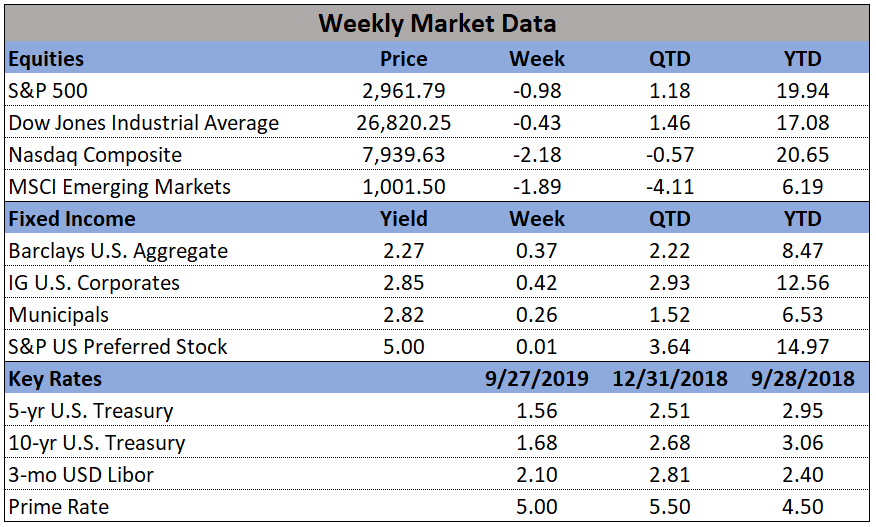In the markets:
U.S. Markets: U.S. stocks managed to move modestly higher this week as most of the major indexes recorded their seventh consecutive week of gains. Within the S&P 500, utilities shares performed the best followed by large industrials and information technology shares. The Dow Jones Industrial Average finished the week up just 42 points to 25,106—a gain of 0.2%. The technology-heavy NASDAQ Composite added 34 points, or 0.5%, closing at 7,298. By market cap, smaller cap stocks continued to outperform with the small cap Russell 2000 index and mid cap S&P 400 indexes rising 0.3% and 0.6%, respectively, while the large cap S&P 500 index finished essentially unchanged, up just 1.3 points.
International Markets: Canada’s TSX rose a seventh week, adding 0.8%, while across the Atlantic the United Kingdom’s FTSE gained 0.7%. However, on Europe’s mainland major markets finished the week in the red. France’s CAC 40 declined -1.1%, along with Germany’s DAX which fell -2.4%. In Asia, China’s Shanghai Composite rose for a fifth consecutive week, up 0.6% and Japan’s Nikkei retreated -2.2%. As grouped by Morgan Stanley Capital International, emerging markets ended the week down -1.4%, while developed markets lost -1.0%.
Commodities: Precious metals retraced some of last week’s gains, with Gold falling -0.3% to $1318.50 an ounce and Silver giving up -0.8% to $15.81 per ounce. In energy, crude oil gave up the last three weeks of gains falling -4.6% to $52.72 per barrel. The industrial metal copper, seen by analysts as a barometer of global economic health due its wide variety of uses, finished the week up 1.4% - its fifth consecutive week of gains.
In the US Economy:
The number of people applying for new unemployment benefits dropped by 19,000 last week to 234,000, retracing most of the big upswing of the previous week. However, the number missed the consensus forecast of a 28,000 decline to 225,000 claims. The monthly average of new claims, smoothed to iron-out the weekly volatility, picked up by 4,500 to 224,750. Claims still remain well below the 300,000 threshold economists use to indicate a “healthy” jobs market. Continuing claims, which counts the number of people already receiving benefits, dropped by 42,000 to 1.74 million. That number is reported with a one-week delay.
Most economic reports originating from the U.S. government are still delayed due to the government shutdown. One that did manage to get released showed that factory orders in the U.S. fell more sharply than expected in November. Orders dropped -0.6% in November, their second consecutive decline and contrary to the consensus forecast of a 0.1% gain. The weakness was largely due to lower oil prices. However, one bright spot was an increase in orders for goods expected to last at least three years - so-called “durable goods” - which rose 0.7%. Durable goods orders were led by defense-oriented aircraft, ships and boats. However, ex-transportation, durable goods orders were actually down 0.4% and have been down three of the last four quarters.
The Institute for Supply Management (ISM) reported that its non-manufacturing index remained in positive territory but fell 1.3 points last month to 56.7, a six-month low. The reading was worse than consensus estimates of a 1-point decline and was its third decline in the past four months. Several industries reported adverse effects from the government shutdown. However analysts note that although services activity has been moderating, it is still showing above trend growth. In the details, the decline was led by a 5.0 point drop in the new orders index—its largest decline since August of 2016. The ISM index is compiled from a survey of executives who order raw materials and other supplies for their companies. The gauge tends to rise or fall in tandem with the health of the economy.
The global slowdown:
Over the past 5 months the United States has set itself apart as the one heating economy surrounded by others who are slowing down. Canada, the U.K., France, Italy, Germany, and China are the largest countries to be affected, with symptoms including reduced factory orders, increasing jobless claims, and slashed growth forecasts. Prime Minister Mark Carney of the U.K. reduced the annual growth forecast to only 1.2% - the lowest since 2009. Germany also dropped its forecast from 1.8% to 1%. China, though still a powerhouse of an economy, is only forecast to grow 6.6%, down from the high sevens in early 2018.
What it means for the US:
The economic slowdown outside of the US will no doubt permeate into the States in the coming months. Reduced exports will lower factory growth rates, the job market will see fewer international applicants, and agriculture will take a hit as international buyers tighten their belts. This slowdown will damage the economy, but it may bring some unexpected silver linings. The most prevalent opportunity is the possibility that the Fed could lower interest rates. A reversal of the current monetary policy in light of new information would jump-start the markets and possibly sustain them into the slowdown. Without this reversal, the outlook for the markets is generally bleak.








